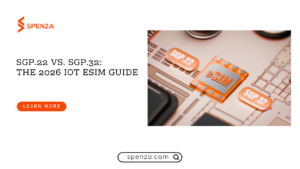Table of Contents
- Introduction
- The Global Compliance Gauntlet: More Than Just Telecom Rules
- Telecom Regulations: The Basics and Beyond
- Privacy & Data Security Compliance
- Identity & Financial Compliance
- Telecom Tax Compliance
- Scale with Compliance, Ease, and Confidence: The Spenza Partnership Model
- Automated Billing & Tax Remittance
- Built-in Global Compliance
- Eliminate Local Overhead
- Case Study: A Regulatorily Compliant MVNO Launch via Spenza
- MVNO Compliance Responsibilities: A Breakdown
- Conclusion: Your Launchpad for Global Growth
- FAQs

Introduction
Launching a global telecom brand in 2025 is bold. Staying compliant while doing it? That’s the biggest roadblock.
MVNOs must clear a tough set of telecom, tax, and privacy rules that shift from country to country. From FCC compliance in the US to GDPR in Europe and CALEA to E911 requirements, it’s a massive load to carry.
And yet, the opportunity is huge. Fortune Business Insights expects the global MVNO market to grow from USD 98.74 billion in 2025 to USD 172.01 billion by 2032.
This guide shows what rules matter most. More importantly, it shows how new MVNOs can clear these hurdles quickly with a trusted partner like Spenza.
If you’re wondering how to set up an MVNO from scratch or scale one in the U.S., Spenza covers every angle. Our guides on how to set up MVNO offer a solid starting point.
The Global Compliance Gauntlet: More Than Just Telecom Rules
The challenge of MVNO regulations is not just about telecom. It’s about data, identity, finance, and tax.
MVNOs planning a global launch have to prepare for multiple compliance layers, far beyond U.S.-specific laws. This includes understanding the difference between MVNE, MVNA, and MNO roles, which Spenza explains in this guide to MVNE, MVNA, and MNO.
Let’s break this down.

Telecom Regulations: The Basics and Beyond
Every country sets its own telecom rules. In the U.S., MVNOs must comply with:
- FCC regulations: These rules define how MVNOs access carrier networks and protect consumers. You must follow FCC processes to get licensed and approved, especially for interconnection and porting.
- CALEA compliance: Under this federal mandate, MVNOs must allow government authorities to perform lawful intercepts. Your network setup must include the technical ability to route call data to law enforcement when authorized.
- E911 requirements: Emergency calls must connect immediately and send location data. This applies to every mobile user on your network, whether they use SIM or eSIM. Non-compliance can result in severe penalties.
- STIR/SHAKEN: These protocols prevent caller ID spoofing. If you allow voice calling, your system must verify the caller’s identity digitally. This cuts down robocalls and helps build trust with users.
Other countries have their own versions. Missing even one requirement can delay your launch.
Privacy & Data Security Compliance
Data privacy is no longer optional. It’s enforced through strict rules like:
- GDPR in Europe
- CCPA in California
- SoC2 compliance telecom requirements for operational security
MVNOs must build trust with users. That starts with proving data is secure. You can’t just say it is, you must show it through audits and certifications.
Identity & Financial Compliance
Know Your Customer (KYC) isn’t just for banks anymore. Many telecom regulators now demand identity checks before activating SIMs or eSIMs. You also need the right to sell services, which means:
- Reseller licenses
- Network agreements
- Number provisioning rights
All of these vary by market.
Telecom Tax Compliance
Taxation for MVNOs is extremely complicated. You’re not just collecting sales tax. You must apply:
- Telecom-specific fees: These charges apply only to communication services and vary by type of offering, voice, text, or data. Each carries different rate rules per region.
- Local 911 surcharges: These are location-based fees collected to fund emergency response infrastructure. They differ from state to state and sometimes by county.
- Universal service funds (USF): A federal-level fee meant to ensure basic telecom access across all areas, including rural ones. MVNOs must contribute based on reported revenues.
- City/state-specific tariffs: These include taxes and regulatory fees imposed by state and local governments. They are layered over federal obligations and require highly accurate calculation and collection.
That changes not only by country, but by region and sometimes even zip code.
Scale with Compliance, Ease, and Confidence: The Spenza Partnership Model
Spenza’s mission is simple: We handle the boring stuff so you can scale safely.
Regulatory chaos stalls many MVNOs. Spenza fixes that with smart automation and global readiness.
Let’s break this down by what Spenza solves for new MVNOs in 2025. If you’re still deciding on the type of MVNO business model to pursue, check out Spenza’s in-depth overview of MVNO models to guide your strategy.
Automated Billing & Tax Remittance
Most MVNOs stumble at telecom tax compliance. Spenza automates:
- Real-time billing
- Tax remittance by region
- Routing between carriers
This removes the burden of configuring taxes manually. Your launch becomes easier, and errors drop to zero.
Built-in Global Compliance
Spenza isn’t just a billing platform. It’s a full-stack compliance engine built for MVNO regulations and full MVNO deployments. It’s built for:
- MVNO regulations
- SoC2 compliance telecom environments
- GDPR and CCPA-ready operations
- KYC workflows
You won’t need consultants or internal compliance teams. The system is already coded for global regulatory rules.
Eliminate Local Overhead
Planning to launch in 10 countries? You don’t need 10 offices.
Spenza acts as your single point of integration. You manage everything from one place. That means:
- No local entity setup
- No expensive legal research
- No regional license negotiations
You get centralized control and complete telecom regulatory compliance.
Case Study: A Regulatorily Compliant MVNO Launch via Spenza
A fast-scaling company wanted to add mobile connectivity to its consumer device offering. They were ready to launch but blocked by multiple regulatory roadblocks.
They had no internal telecom team. No licensing expertise. No way to handle SIM logistics, KYC checks, or emergency service compliance.
They turned to Spenza for support.
What Spenza Provided:
- Pre-built SIM and eSIM provisioning system
- Real-time billing and usage reporting
- Fully compliant onboarding flows (FCC, KYC, E911)
- Shopify-ready integration for consumer management
Outcome:
- Launched mobile-ready product in only 10 days. Handled provisioning, billing, and activation in one flow. Customers onboarded themselves using a custom-branded app.
- KYC, E911, and CALEA compliance was automatic. No legal or tech intervention was needed. Rules handled quietly in the background.
- SIM and eSIM provisioning worked out of the box. No manual setup or delay. Customers chose their activation path.
- Billing ran live and accurately from day one. Taxes and surcharges applied automatically. Errors avoided entirely.
- Global readiness required zero extra effort. The MVNO launched without setting up any local teams. Compliance didn’t slow them down.
This case proves that startups without telecom knowledge can still meet all MVNO regulations and launch like pros. Spenza makes the compliance part invisible so product teams can focus on customer experience and scale.
MVNO Compliance Responsibilities: A Breakdown
Launching a telecom service comes with obligations that are far from simple. You need more than just a working SIM card. From lawful intercept to tax setup, from secure data handling to real-time user onboarding, the workload is intense.
Every area has a different requirement. And each layer must pass strict checks. Below is a detailed view of what new MVNOs are expected to manage, and how Spenza makes it simple.
| Compliance Area | Required Elements | Covered by Spenza |
|---|---|---|
| Telecom Regulations | FCC, E911, CALEA, STIR/SHAKEN | ✅ Yes |
| Privacy & Security | SoC2, GDPR, CCPA, secure API management | ✅ Yes |
| Identity Compliance | KYC, SIM/eSIM activation, age verification | ✅ Yes |
| Tax Compliance | Region-based telecom tax, USF, 911, surcharges | ✅ Yes |
| Reseller Rights | Carrier agreements, number provisioning rights | ✅ Yes |
| Infrastructure Provisioning | SIM management, eSIM provisioning, usage tracking | ✅ Yes |
Conclusion: Your Launchpad for Global Growth
The list of telecom, privacy, identity, and tax regulations is long. Most MVNOs spend months just trying to meet the basics.
With Spenza, you skip the slow part. You stay fully aligned with MVNO regulations. You launch globally, fast. And you focus only on what matters: your service, your brand, your customers.
FAQs
MVNO regulations in 2025 cover telecom rules, identity verification (KYC), emergency response (E911), lawful intercept (CALEA), and telecom tax compliance. Each country has its own version, and missing even one part can block your launch.
Telecom taxes change by city, state, and country. You must calculate, collect, and remit taxes like E911 fees and USF charges. Tools like Spenza automate this process to avoid mistakes and penalties.
SoC2 compliance telecom means proving your platform protects user data. It involves strict audits and secure infrastructure. Spenza has SoC2 built in, so MVNOs don’t need to handle this alone.
Not with Spenza. Spenza acts as your global compliance hub. You don’t need local teams, licenses, or infrastructure in each country to meet MVNO regulations.
You can launch in under two weeks. Spenza’s pre-approved systems cover telecom regulatory compliance, SIM provisioning, billing, and customer onboarding.
Yes. CALEA mandates lawful intercept access for government authorities. All U.S. MVNOs must support this, and Spenza handles it automatically in the platform.
Spenza is not a traditional telecom provider. It’s a cloud-based MVNE that helps you start a MVNO or grow as a reseller, MSP, or IoT solutions provider.
Ready to scale your telecom vision globally without the regulatory headache? Contact Spenza to learn how our platform lets you launch with confidence.






